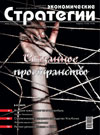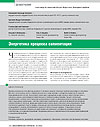Sapientation Process Energy
The authors have studied the possibility of taking into account the human rationality factor in the analysis of global problems of demography and energy. For this purpose, analogues of chemical kinetics and the idea of human communities as an open thermodynamic system were applied. The demography of sapientation was divided into two conventional energy zones — northern and southern, which differ in climatic and geophysical conditions. The sapientation process was formalized by correlating the number of creative and educated people with the amount of external energy they convert into new valuable information. The sapientation kinetics was modeled completing the formalism of the act of a person’s birth with a stage of his education requiring the involvement of at least one teacher from among educated people. The second-order kinetic equation, describing the growth of an equal population of men and women of reproductive age, was transformed into an equation of the third and higher orders. The stationary solution of these equations determines the optimal demography for sustainable noospheric development of the population in accordance with its education index. Real and durable solutions to the demographic and energy problems are proposed.
References:
- Kholmanskiy A.S., Strebkov D.S. Energetika noosfery [Energetics of Noosphere]. Doklady RASKhN, 2004, no 1, pp. 58–60.
- Kholmanskiy A.S. Fizicheskie faktory antropogeneza [Physical Factors of Anthropogenesis]. Vestnik Russkogo Dukha, 2013, no 1(7), pp. 84–99, available at: http://technic.itizdat.ru/docs/aholy/FIL13806198710N114377001/5.
- Kholmanskiy А. Chirality anomalies of water solutions of saccharides. Journal of Molecular Liquids, 2016, no 216, pp. 683–687.
- Kholmanskiy A.S. Galakticheskii faktor dukhovnoi evolyutsii [Galactic Factor of Spiritual Evolution]. Asimmetriya, 2009, 1. S. 63–71, available at: http://cerebral-asymmetry.narod.ru/Asymmetry_1_2009.pdf
- Kholmanskiy A.S. Khiral’nost’ i kvantovye effekty kak faktory morfogeneza [Chirality and Quantum Effects as Morphogenesis Factors]. Matematicheskaya morfologiya. Elektronnyi matematicheskii i mediko-biologicheskii zhurnal, 2010, tom 9, vyp. 4, available at: http://www.smolensk.ru/user/sgma/MMORPH/N-28-html/kholmanskiy-2/kholmanskiy-2.htm.
- Blyumenfel’d L.A. Reshaemye i nereshaemye problemy biologicheskoi fiziki [Solvable and Unsolvable Problems of Biological Physics]. Moscow, Editorial, URSS, 2002, 160 p.
- Kholmanskiy А. Clever Christianity. European Journal of Social Sciences, 2014, vol. 41, no 3, pp. 356–362, available at: http://www.europeanjournalofsocialsciences.com/issues/ejss_41_3.html; http://www.sciteclibrary.ru/texsts/eng/stat/st5898eng.pdf.
- Schetchik naseleniya Zemli, 02.04.2017 [World Population Counter, 02.04.2017]. Countrymeters, available at: http://countrymeters.info/ru/World.
- Reiting stran mira po urovnyu obrazovaniya [World Countries Ranking by the Level of Education]. GT: Gumanitarnye tekhnologii, available at: http://gtmarket.ru/ratings/education-index/education-index-info.
- Tesla N. Stat’i [Articles]. Samara, 2008, available at: http://library.raikevich.com/tesla/index1.html#00
- Bogdankevich O.V. Lektsii po ekologii [Lectures on Ecology]. Moscow, 2002, 206 p.
- Nurgaliev I.S. Vikhri novykh riskov trebuyut peresmotra strategii razvitiya [Whirlwinds of New Risks Require Revision of Development Strategies]. Ekonomicheskie strategii, 2011, no 6, pp. 56–60.
- Kholmanskiy A.S. Dikhotomiya pravogo i levogo v zhivykh sistemakh [Right and Left Dichotomy in Living Systems]. Asimmetriya, 2008, no 3, pp. 60–67, available at: http://cerebral-asymmetry.ru/Asymmetry_03_2008.pdf.
- Apolikhin O.I., Moskaleva N.G., Komarova V.A. Sovremennaya demograficheskaya situatsiya i problemy uluchsheniya reproduktivnogo zdorov’ya naseleniya Rossii [Current Demographic Situation and the Problems of Improving the Russian Population’s Reproductive Health]. Eksperimental’naya i klinicheskaya urologiya, 2015, no 4, available at: http://ecuro.ru/node/3567.
- Bodriiyar Zh. Obshchestvo potrebleniya. Ego mify i struktury [Consumer Society. Its Myths and Structures]. Moscow, Respublika, 2006.
- Kholmanskiy A.S. Apofeoz akhiral’nosti [Achirality Apotheosis]. Soznanie i fizicheskaya real’nost’, 2009, no 9, pp. 29–35, available at: http://technic.itizdat.ru/docs/aholy/FIL13590233540N024196001/1.
- Nizovtsev V.V. Vremya i mesto fiziki XX veka [Time and Place of Physics of the XX Century]. Moscow, Editorial, URSS, 2000, 201 p.
- Bezrukikh P.P., Strebkov D.S., Kholmanskiy A.S. Perspektivnye napravleniya razvitiya vozobnovlyaemykh istochnikov energii [Perspective Directions of Renewable Energy Sources Development]. Vestnik VIESKh, 2016, no 4, pp. 96–101.
- Strebkov D.S., Rink L.I., Stenin V.V., Kurbatov S.M. O razvitii kremnievoi solnechnoi energetiki [On the Development of Silicon Solar Power Engineering]. Vestnik RASKhN, 2014, no 3, pp. 17–18.
- Buchachenko A.L. Magnitoplastichnost’ i fizika zemletryasenii. Mozhno li predotvratit’ katastrofu? [Magnetoplasticity and Earthquake Physics. Is it Possible to Prevent a Catastrophe?]. UFN, 2014, no 184, pp. 101–108.
- Kholmanskiy A.S. Khiral’naya pustota [Chiral Void]. Matematicheskaya morfologiya. Elektronnyi matematicheskii i mediko-biologicheskii zhurnal, 2008, tom 7, vyp. 1, available at: http://technic.itizdat.ru/docs/aholy/FIL13590236410N597734001/1



